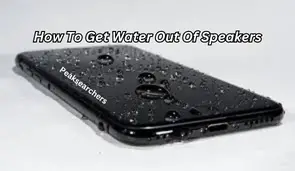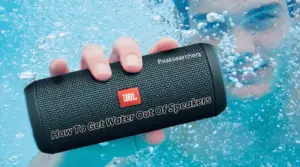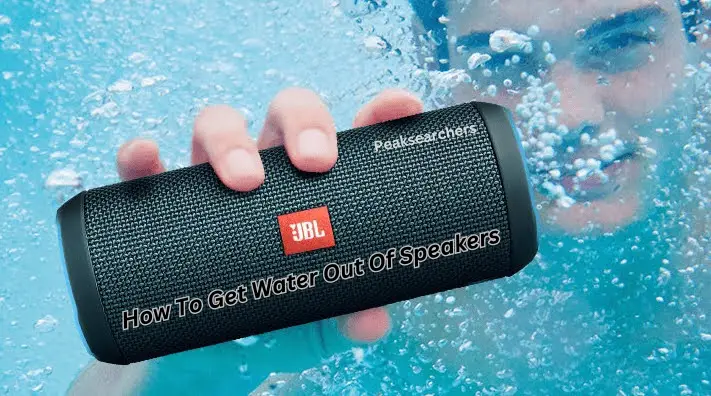How To Get Water Out Of Speakers? A DIY Guide
Welcome to our comprehensive guide on how to remove water from speakers. Accidental spills or exposure to moisture can be a nightmare for any speaker owner. The presence of water can affect the performance and quality of sound, potentially causing irreversible damage. In this article, we will provide you with step-by-step instructions to effectively remove water from your speakers and restore them to their optimal condition.

1. Understanding the Impact of Water on Speakers
Water can significantly affect the performance and longevity of speakers. When water enters the speaker components, it can cause electrical shorts, corrosion, or damage to delicate parts.
This can result in distorted sound quality, loss of volume, or complete speaker failure. It is crucial to address the issue promptly to prevent permanent damage.
2. Safety Precautions
Before attempting any water removal methods, ensure you prioritize safety. Here are some essential safety precautions to follow:
- Disconnect the speaker from the power source.
- Unplug any cables connected to the speaker.
- If the speaker is part of a larger system, power down the entire system.
- Take necessary precautions to avoid electric shock, such as wearing rubber gloves or using insulated tools.
3. Drying Techniques
There are several effective methods for drying out speakers. Choose the one that suits your situation and the severity of the water damage.
Method 1: Air Drying
Air drying is the simplest and most accessible method to remove water from speakers. Follow these steps:
- Gently pat the speaker dry using a soft, absorbent cloth.
- Place the speaker in a well-ventilated area at room temperature.
- Allow the speaker to air dry for at least 24 to 48 hours. Avoid using heat sources like hairdryers, as they can cause further damage.
Method 2: Rice or Silica Gel
Rice or silica gel packets can absorb moisture effectively. Here’s how to use them:
- Remove any excess water from the speaker using a soft cloth.
- Fill a container with rice or silica gel packets.
- Place the speaker in the container and bury it completely.
- Seal the container and leave it undisturbed for 24 to 48 hours, allowing the moisture to be absorbed.
Method 3: Vacuuming
If the water has seeped deeper into the speaker, vacuuming can help extract it. Follow these steps:
- Attach a brush attachment to a vacuum cleaner.
- Set the vacuum to a low suction level.
- Gently run the brush attachment across the speaker surface, allowing it to extract any trapped water.
- Ensure not to make direct contact with delicate speaker components.
Method 4: Using a Dehumidifier
If you have a dehumidifier at your disposal, this method can expedite the drying process. Here’s how to use it:
- Place the speaker in a small, enclosed space with the dehumidifier.
- Ensure the dehumidifier is set to a low humidity level.
- Allow the dehumidifier to run for 24 to 48 hours, aiding in the removal of moisture.
4. Speaker Disassembly (if necessary)
If the water damage is extensive or the methods mentioned above haven’t resolved the issue, you may need to disassemble the speaker for a thorough cleaning.
This step requires caution and technical expertise. If you’re not comfortable with disassembly, it’s advisable to consult a professional technician.
5. Cleaning Components
Cleaning the various components of the speaker can help eliminate water residue and prevent further damage. Here’s how to clean specific parts:
Cleaning the Speaker Cone
- Gently wipe the cone with a soft, lint-free cloth to remove any visible water or debris.
- If necessary, use a mild soap solution and a soft brush to clean the cone.
- Ensure the cone is completely dry before reassembling.
Voice Coil’s Cleaning
If you’re unsure or uncomfortable, it’s best to seek professional assistance. Here’s a general overview:
- Disassemble the speaker carefully, exposing the voice coil.
- Use compressed air or a soft brush to remove any moisture or debris.
- If necessary, clean the voice coil with a specialized electrical contact cleaner.
- Allow the voice coil to dry completely before reassembling.
Cleaning the Speaker Enclosure
- If the enclosure has absorbed water, remove any detachable parts and allow them to dry separately.
- Wipe the interior and exterior of the enclosure with a soft, damp cloth.
- Ensure the enclosure is completely dry before reattaching any parts.
6. Testing and Reassembly
After following the appropriate drying and cleaning methods, it’s crucial to test the speaker’s functionality before reassembly.
Reconnect the speaker to the power source and audio system, then play some audio to verify if the issue has been resolved. If the sound quality is satisfactory, proceed with reassembling the speaker.
7. Preventive Measures to Avoid Future Water Damage
To minimize the risk of future water damage to your speakers, consider implementing the following preventive measures:
- Keep speakers away from potential water sources, such as open windows or areas prone to spills.
- Invest in waterproof or water-resistant speaker options for added protection.
- Utilize speaker covers or protective cases when transporting or storing speakers.
- Regularly inspect and maintain speaker components to identify any potential issues early on.

Also Read: How to Connect Speakers to Your TV? A Comprehensive Guide
FAQ’s
How do I eject the water speaker from my iPhone?
To eject water from your iPhone speaker, you can try the following steps:
- Start by gently shaking your iPhone to remove any excess water trapped in the speaker ports. Make sure to hold the device securely to prevent it from slipping out of your hand.
- If shaking alone doesn’t work, you can use compressed air to blow into the speaker ports. This can help dislodge any water that may be trapped inside. Be careful not to use excessive force or hold the can of compressed air too close to the device.
- Another method you can try is using a vacuum cleaner. Set it to the lowest power setting and place the nozzle near the speaker ports. The suction created by the vacuum can help draw out any remaining water.
- If the water doesn’t come out with shaking, compressed air, or a vacuum, you can try the rice method. Place your iPhone in a container filled with uncooked rice and leave it there for at least 24-48 hours. The rice will absorb the moisture from the device, including the speaker area.
- After following any of the above methods, give your iPhone some time to dry out completely before attempting to use it again. This can help prevent any potential damage to the internal components.
Remember, these methods may help remove water from the speaker, but they do not guarantee a complete fix.
How to clean the dust from your speaker?
To clean the dust from your speaker, you can follow these steps:
- Start by powering off your device. This will prevent any accidental actions while you’re cleaning the speaker.
- Gently inspect the speaker grille or vents to identify any visible dust or debris. You can use a flashlight to get a better view.
- Take a soft-bristled brush, such as a clean, dry toothbrush or a small paintbrush, and lightly brush the speaker grille or vents in a downward motion. This will help dislodge the dust particles.
- Alternatively, you can use compressed air to blow away the dust. Hold the can of compressed air at a slight distance from the speaker grille or vents and use short bursts of air to avoid applying too much pressure.
- If the dust is particularly stubborn or hard to reach, you can use a cotton swab or a soft cloth dampened with a small amount of isopropyl alcohol (rubbing alcohol) or water. Gently wipe the speaker grille or vents to remove the dust. Be cautious not to use excessive liquid or get it into the device.
- Once you’ve finished cleaning, allow the speaker to air dry for a few minutes before turning your device back on.
It’s important to note that cleaning the speaker may improve the sound quality if dust or debris was affecting it, but it won’t fix any underlying hardware issues. If you continue to experience problems with the speaker even after cleaning, it’s advisable to contact the manufacturer or seek professional assistance.
How to fix my speaker bass?
If you’re experiencing issues with the bass on your speakers, here are a few steps you can take to try and fix it:
- Check audio settings and adjust the equalizer for better bass.
- Ensure proper speaker placement, away from walls or corners.
- Verify secure and undamaged speaker cables.
- Adjust any dedicated bass controls or settings on the speakers.
- Use high-quality audio sources with sufficient bass content.
- Consider adding a subwoofer for enhanced bass response.
- If issues persist, contact the manufacturer or seek professional assistance.
Also Read: Do All Of The Monitors Have Speakers? A Complete Detail
Conclusion
We hope this comprehensive guide has provided you with the necessary knowledge and steps to successfully remove water from your speakers.
By following these instructions, you can minimize the risk of permanent damage and enjoy high-quality sound for years to come.
Remember to prioritize safety and, if needed, consult professional assistance for extensive damage. Keep your speakers dry, and they will continue to bring you exceptional audio experiences.


